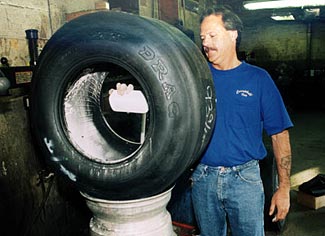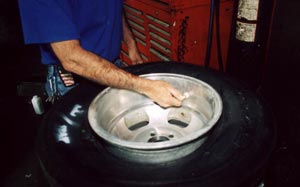
The bottom line on tubes and racing slicks
is this: tubes are expensive, but the decision
on whether or not to run a tube should never
be a financial decision. It should always be
a safety and performance issue -- as with anything
else on your race car.
 |
We've always had David
Geddings of Campbell Tire in Alpharetta,
Georgia mount our slicks, and he has the
routine down pat. First he lays the slick
onto a standard tire-mounting machine, then
places the tube on top. He then fills the
natural rubber tube with about 10 pounds
of air, to ensure there are no wrinkles
in it (lead photo). Then David deflates
the tube. |
| The trick to a flawless
tube-and-slick mount is to use baby powder
as a "dry" lubricant, to ensure the tube
doesn't stick to the inside of the slick.
Mickey Thompson engineers say DO NOT use
wet lubricant inside the tire, such as a
light machine oil. It will attack the rubber
and cause the tube to stick. Any cheap talc
will do here. Notice how David has just
about filled the inside of the slick with
baby powder. |
 |

David mounts the tube inside the slick
and aired it up -- standard operating
procedure for any tube and tire. |

Then he checks the balance on a rotating
balancing machine. |
 |
The tube valve stem is
then checked for its "seat" and leaks. All
Mickey Thompson tubes come with their own
locking nut, to ensure the tube doesn't
slip inside the slick. |

|